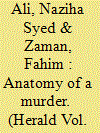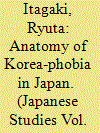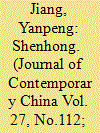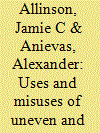|
|
|
Sort Order |
|
|
|
Items / Page
|
|
|
|
|
|
|
| Srl | Item |
| 1 |
ID:
139752


|
|
|
|
|
| Summary/Abstract |
IT was a 9mm gun, probably a Stoeger. Before Saad Aziz got this “samaan” through an associate, by his own admission, he had already plotted a murder. On the evening of Friday, April 24, 2015, he met four other young men, all well-educated like him, somewhere on Karachi’s Tariq Road to finalise and carry out the plot. As dusk deepened into night, they set off towards Defence Housing Society Phase II Extension on three motorcycles. Their destination: a café-cum-communal space – The Second Floor or T2F – where an event, Unsilencing Balochistan: take two, was under way. Their target: Sabeen Mahmud, 40, the founder and director of T2F.
|
|
|
|
|
|
|
|
|
|
|
|
|
|
|
|
| 2 |
ID:
140345


|
|
|
|
|
| Summary/Abstract |
This article explores the history and theoretical implications of Korea-phobia in Japan, focusing on hate incidents such as a demonstration by the Zaitokukai group which hoisted flags and blasted hate speech through a loudspeaker at an elementary school for Korean children in Kyoto in 2009. An analysis of such speech reveals that these actions are not so new, and instead rely on what we might call the historical layers of Korea-phobia in Japan. Korea-phobia in contemporary Japan must be understood from a historical perspective that traces anti-Korean racism back to the opening decade of the twentieth century when Japan seized Korea as a colony.
|
|
|
|
|
|
|
|
|
|
|
|
|
|
|
|
| 3 |
ID:
159917


|
|
|
|
|
| Summary/Abstract |
Shanghai, like other large Chinese cities, has multiple business districts. This paper examines the construction of one of its largest, at Hongqiao in the west of the city. Its specific focus lies in the central role played by one state-owned company, Shenhong, in the financing and construction first of the Hongqiao transport hub and then of the business district that jointly make up this new development pole. The paper examines in detail Shenhong as an organization as well as the tasks it has undertaken and the funding difficulties it has confronted. It argues that Shenhong is representative of the seldom discussed state-owned urban investment and development companies that have led the urbanization of China. Finally, it anchors these companies into theoretical debates, arguing that their ubiquitous involvement in China’s property-led process of urban transformation combined with their ambivalence as state companies operating along similar lines to private enterprises means that they can be seen as central players in a form of state corporatist urbanism.
|
|
|
|
|
|
|
|
|
|
|
|
|
|
|
|
| 4 |
ID:
087855


|
|
|
|
|
| Publication |
2009.
|
| Summary/Abstract |
A central concern of much contemporary Marxist scholarship in international relations (IR) is to internally relate global capitalism and the state system without reducing one of these systems to an epiphenomenon of the other. A recent attempt at this is Justin Rosenberg's reformulation of Leon Trotsky's idea of uneven and combined development (U&CD). This article examines the internal relations of 'unevenness' and 'combination' as presented by Trotsky and reworked by Rosenberg. From this anatomization of the concept, we focus on the problematic status of U&CD as a transhistorical general abstraction arising from the exchange between Callinicos and Rosenberg (Cambridge Review of International Affairs, 22:1 2008, 77-112) and suggest our own possible solution. We argue that while the uneven and combined nature of historical development represents a truly transhistorical phenomenon, its distinct causal determinations, articulated and expressed through inter-societal competition, are only fully activated under the specific socio-historical conditions of generalized commodity production. These theoretical points are illuminated through three specific historical examples (the Meiji Restoration, the 'Eastern Question' and the origins of the two World Wars). Finally, we illustrate some of the dangers of analytical overextension found in Rosenberg's own ambiguous use of U&CD.
|
|
|
|
|
|
|
|
|
|
|
|
|
|
|
|
|
|
|
|
|